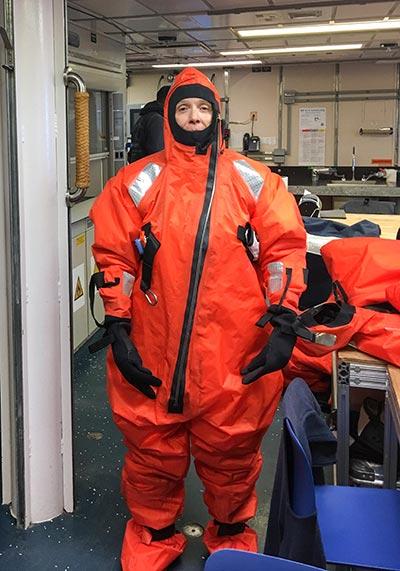From the Atlantic to the Arctic Ocean

Lisa Seff, a veteran science teacher at the Springs School, was on top of the world on Monday. While many here may have felt on top of the world in Labor Day’s perfect weather, Ms. Seff was actually there.
She was on board the 261-foot Research Vessel Sikuliaq, which is traveling north of the Arctic Circle in the world’s northernmost and coldest ocean basin, where the air temperature was approximately 36 degrees and the water, a mere 41 degrees. The area is only traversable during late summer when thick ice melts and creates a channel.
Since Aug. 24, Ms. Seff has lived on the ship along with about 20 researchers and 22 crew members selected to be part of PolarTREC (Teachers and Researchers Exploring and Collaborating), a program managed by ARCUS, the Arctic Research Consortium of the United States, and funded by the National Science Foundation Office of Polar Programs. Led by Carin Ashjian of the Woods Hole Oceanographic Institution, the ship is coursing through the Arctic Ocean and will remain at sea until Sept. 18, while the team studies currents, salinity, food, from plankton to zooplankton, Arctic cod, beluga whales, and sea birds.
In an email from the ship, Ms. Seff wrote that the expedition had been named “Arctic Winds, Fish, Fins, and Feathers.”
Next Thursday at 9 a.m., the entire Springs School will be connected to Ms. Seff and the scientists on board the Sikuliaq via a live webinar, during which students will have an opportunity to speak with the researchers and ask about their expedition and discoveries.
Some curious Springs students have already been keeping track of their teacher’s adventures. The PolarTREC funding she received included a web platform on which she keeps a journal that allows students and the public to chart her course and get a glimpse of life on board an oceangoing vessel. Each journal post includes an Ask the Team link, Ms. Seff explained, creating a rare experience for those interested to live through her journey vicariously.
Through the journal entries, students and fellow scientists can learn of detailed accounts of the team’s daily work. According to Ms. Seff, each researcher works in 12-hour shifts so that studies are conducted around the clock. While zooplankton and other microscopic floating vegetation provide learning opportunities, perhaps even more fascinating for students is what life is like on board one of the newest and most advanced oceanographic research vessels in the world, designed to cut through a 2.5-foot ice shelf as easily as a knife through warm butter.
To that end, Ms. Seff provided details of her voyage on the sometimes tumultuous sea. “When we’re on deck and any work is going on, everyone is required to wear a floatation device and a hard hat. We need to think about every step we take, whether it’s to use the bathroom, move equipment on a wet or icy deck, walk from one lab to another, or move between decks. “Though the Sikuliaq has been relatively stable, it is constantly rolling and as the seas grow and winds increase, even taking a shower or sleeping can be a challenge,” she wrote.
She also posted pictures of her room, which she called cozy and shared with a fellow researcher. “All the drawers in our room, and on the ship, have special latches so they stay shut in rough and rolling seas,” Ms. Seff wrote. “One of my favorite parts of the room is the television. And while we can’t tune into the latest ‘Game of Thrones’ or ‘Sponge Bob,’ we can see” the back deck, the position on a map screen, the present weather trends, and the ship’s course. “It’s all ‘live’ TV and really very helpful. The Sikuliaq is a big ship and the television stations help us all stay tuned into what’s going on in every part of the ship.”
With regard to seasickness, Ms. Seff wrote, “I don’t usually get seasick. My hypothesis is that my parents threw my sister and me into boats when we were very young and I just am used to the motion. The Arctic can get pretty rough, especially at this time of the year, a few people have been seasick, however, it seems that medications and fortitude allow them to get through it and continue with the work.”
Ms. Seff, who has taught at Springs for 17 years, called herself a proponent of “blowing the walls off of the classroom” by virtually taking students along on her far-flung expeditions. “By engaging students with some of the top research scientists in the world, and providing a means for them to directly connect with the research team is something that I’ve found has direct impacts on student interest in science and the world around them.”
The public at large will be welcomed to join the live webinar next Thursday at 9 a.m. by preregistering at www.polartrec.com. On the same page, viewers can also connect to Ms. Seff’s journals and post questions. To follow Research Vessel Sikuliaq’s course over the next 10 days, one would visit: www.sikuliaq.alaska.edu/track/.
